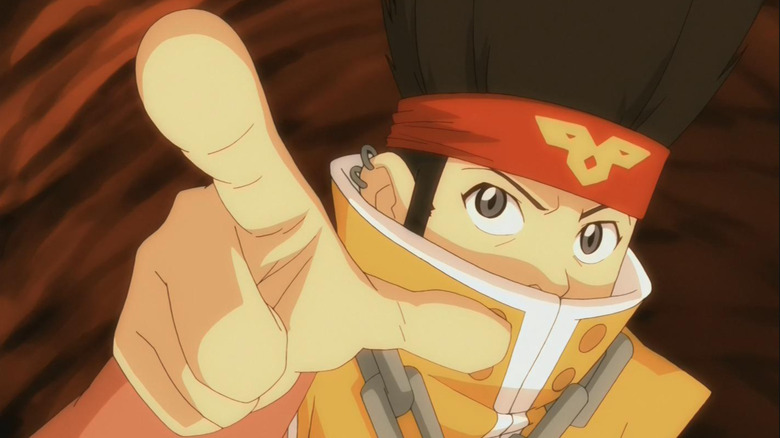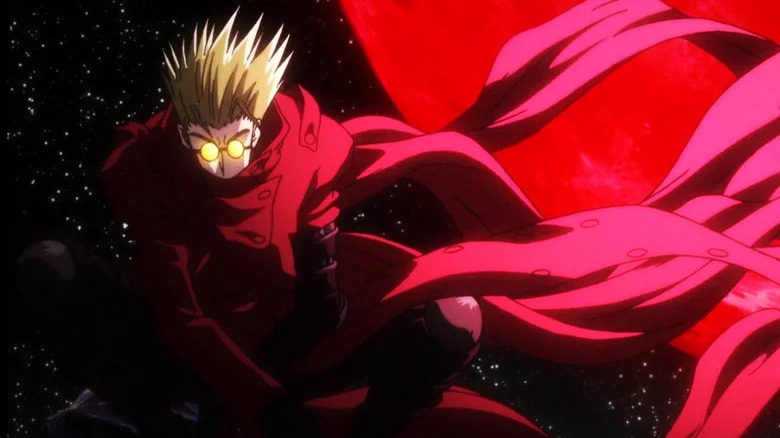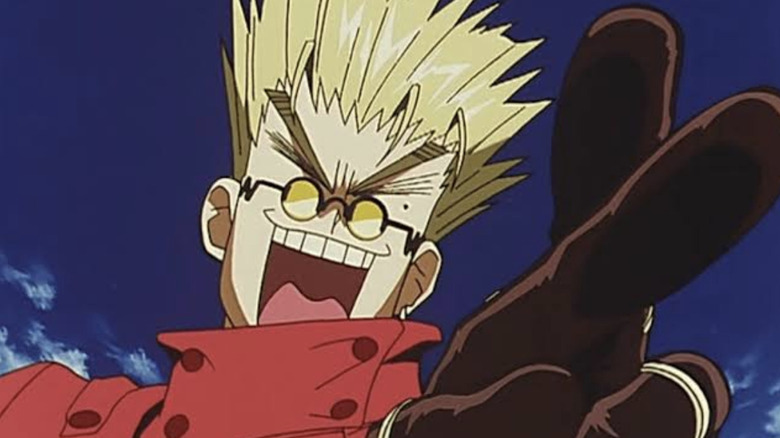An Avatar: The Last Airbender Episode Features Aang Dressed Like Other Anime Heroes
I'm not blowing any minds by saying that "Avatar: The Last Airbender" took a lot of influence from anime. The characters are drawn in a way that they'd look right at home in an anime, but sometimes, the series' influences manifested more specifically. For instance, the season 1 spirit Hei Bai was inspired by the monstrous Angels from the classic mecha anime "Neon Genesis Evangelion." Jet, the anti-heroic leader of the Freedom Fighters, is likewise modeled on Spike Spiegel from "Cowboy Bebop" (and they share similar "unclear" death scenes). Since "Avatar" aired on Nickelodeon, Jet chews on a wheat thread instead of cigarettes like Spike.
These anime allusions aren't limited to supporting characters, either. In the season 3 episode "Nightmares and Daydreams," our hero — Avatar Aang — imagines himself facing the worst of the worst — Fire Lord Ozai. Neither hero nor villain are wearing their usual threads and across the dreams, they change appearance. With Ozai, it makes sense; Aang hasn't seen his adversary in person yet and his imagination is running wild.
Aang's outfits, though, are inspired by costumes from other animes (albeit still in Aang's usual Air Nomad colors of orange and yellow). In the first dream, Aang is dressed like Goku from "Dragon Ball," with spikey hair and a martial arts gi. In the second, he's dressed like Vash the Stampede from "Trigun" — he has spiky hair standing straight up and a turtleneck duster flowing down past his ankles. Dream-Aang doesn't have Vash's shades, but he does have the earrings.
For me, these homages invite more than just skin-deep comparisons.
An anime hero just like The Last Airbender
Though the creator of "Dragon Ball," the late Akira Toriyama, didn't set out to create a phenomenon, the series is the biggest anime in the world. It and "Trigun" were also part of the '90s U.S. anime boom that swept up "Avatar" co-creators Bryan Konietzko and Michael Dante DiMartino. It especially makes sense that "Avatar" homages "Trigun," a Western with more on its mind than gunslinging, because Aang and Vash are similar characters.
Vash is a nomad with a tragic past who carries the memory of his adopted mother Rem close to him. Despite wielding great power, he's a friendly bloke who prefers to mess around and vows to never take a life — a commitment his enemies test. These broad strokes describe Aang too. The Avatar is a kid with a prankster's heart, but he has to grow up into a savior because his divine duty is to protect an endangered world.
"Trigun" uses a lot of Christian imagery and themes. One of Vash's allies, Nicholas D. Wolfwood, is a literal priest. Since this is the Wild West, Wolfwood does carry a gun — a heavy, human-sized, and cross-shaped one that he carries on his back. Sound familiar? The story of Jesus carrying the crucifix to his execution at Golgotha is meant to represent how he's taken the sins of humanity onto his shoulders so that we might see salvation. That's where the phrase "cross to bear" comes from, i.e. God tasks all of us with suffering that we must endure. If his own son could manage it, so can we.
Wolfwood's cross isn't the only one in "Trigun." When Vash preaches "Love and Peace," he crosses his fingers together. The cross remains a symbol of good intent even in the far future.
Pacificism in Trigun and Avatar: The Last Airbender
Vash and his evil brother Knives are "plants" (interdimensional beings who might be literal angels). Unlike other plants, though, they look human and are capable of living in the physical world; i.e. they're both human and divine, like Christ himself.
Some critics have suggested that Vash and Knives' sibling rivalry is meant to echo the biblical story of Cain and Abel, sons of Adam and Eve after they were cast from paradise; Cain killed his brother and was marked by God as punishment. Knives isn't out to kill his brother per se, but he wants to defeat him and extinguish his fondness for humanity. Knives leads a cult called the Eye of Michael, as in Saint Michael the Archangel, "Our protection against the wickedness and snares of the Devil." Appropriating Saint Michael's name and mission shows how Knives sees himself as a smiter of evil, with humans being the devils of his twisted worldview.
There are even rumors that "Trigun" creator Yasuhiro Nightow is a Christian himself. From my own research, Nightow has not confirmed this (he even described himself as irreligious in 2009). However, even if Nightow doesn't practice Christianity, it seems likely that the Christian ideas in "Trigun" gave this rumor credence to the series' fans, hence why it spread.
Vash's pacifism is about turning the other cheek as Christ (and Rem) preached. "Trigun" is a more adult series than "Avatar: The Last Airbender" and holds back easy answers. Vash sometimes fails, both in upholding his ideals and because of them. Still, like Aang's controversial decision to spare Ozai when he finally faces the Fire Lord in the "Avatar" finale "Sozin's Comet," Vash's last choice in the "Trigun" anime is choosing forgiveness.


